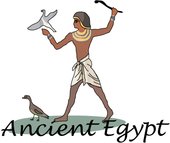Tawaret
|
|
She was depicted as an amalgam of human and animal: roughly humanoid and standing upright, but having the head of a hippopotamus with the arms and legs of a lion, the back and tail of a crocodile, and the pendulous breasts and large stomach of a pregnant woman. She also had a wig of long straight hair. She was often shown with one arm resting on the sa symbol, which symbolized protection, and on occasion carried an ankh, the symbol of life, or a knife, which would be used to threaten evil spirits. She would sometimes be depicted with a crocodile resting or riding on her back rather than having a crocodile's back herself. Her unusual appearance was reputed to ward off bad spirits.
The origins of the goddess are unclear, but Tawaret first came to prominence in the third millennium BC during the time of the Old Kingdom. She was known then by three names: Opet or Ipet or Ipy ("favoured place"), Reret ("the sow"), and Tawaret ("the great one"), the name by which she later became best known. Opet and Reret were initially separate goddesses, worshipped at Thebes and Het-Khaat, respectively (Opet was said to be the mother of Osiris), but both were eventually subsumed into the worship of Tawaret. At the height of her popularity, many Thebean children would be named for her.
Tawaret was worshipped in people's homes rather than in temples. Personal amulets depicting the goddess were often worn or kept in the home, with images appearing on domestic items such as on beds, headrests and cosmetic articles. Her image could be found on knives made from hippopotamus ivory, which would be used as wands in rituals to drive evil spirits away from mothers and children. She was also depicted in temple reliefs in conjunction with other Egyptian deities, as well as in the Book of the Dead.
Tawaret was associated with the hippopotamus, one of the many sacred animals of the Egyptians. Through this connection, she was also associated with the northern sky, in which the hippopotamus was represented as a constellation, the present-day Draco. She was described as the "mistress of the horizon" when she was depicted on the ceiling of the tomb of Seti I in the Valley of the Kings. As the hippopotamus was associated with the Nile, she was also seen as a goddess of seasonal rebirth, the annual flooding of the Nile, and harvests.
In later times, when Horus came to prominence, Tawaret was viewed as somewhat of an evil god, due to her position as the concubine of Set. Set had originally been a benign god, but beliefs about him gradually absorbed the characteristics of all the evil gods, similarly tainting Tawaret. However, since she sided with Horus over Set in his claim to the throne of Egypt, this characteristic was regarded as partly balanced, making her more of a neutral figure overall.
The Rosicrucian Egyptian Museum at San Jose, California, United States, has Tawaret at its entrance.
Ancient Egypt Clipart and Pictures
- Ancient Egypt Architecture (http://classroomclipart.com/cgi-bin/kids/imageFolio.cgi?direct=History/Ancient_Civilizations/Ancient_Egypt/Architecture)
- Ancient Egypt Art (http://classroomclipart.com/cgi-bin/kids/imageFolio.cgi?direct=History/Ancient_Civilizations/Ancient_Egypt/Art)
- Ancient Egypt Clipart (http://classroomclipart.com/cgi-bin/kids/imageFolio.cgi?direct=History/Ancient_Civilizations/Ancient_Egypt/Clipart)
- Ancient Egypt Clothing (http://classroomclipart.com/cgi-bin/kids/imageFolio.cgi?direct=History/Ancient_Civilizations/Ancient_Egypt/Clothing)
- Ancient Egypt Architecture (http://classroomclipart.com/cgi-bin/kids/imageFolio.cgi?direct=History/Ancient_Civilizations/Ancient_Egypt/Commerce)
- Ancient Egypt Daily Life (http://classroomclipart.com/cgi-bin/kids/imageFolio.cgi?direct=History/Ancient_Civilizations/Ancient_Egypt/Daily_Life)
- Ancient Egypt Games and Toys (http://classroomclipart.com/cgi-bin/kids/imageFolio.cgi?direct=History/Ancient_Civilizations/Ancient_Egypt/Games_and_Toys)
- Ancient Egypt Hieroglyphs (http://classroomclipart.com/cgi-bin/kids/imageFolio.cgi?direct=History/Ancient_Civilizations/Ancient_Egypt/Hieroglyphs)
- Ancient Egypt People (http://classroomclipart.com/cgi-bin/kids/imageFolio.cgi?direct=History/Ancient_Civilizations/Ancient_Egypt/Historical_People)
- Ancient Egypt Illustrations (http://classroomclipart.com/cgi-bin/kids/imageFolio.cgi?direct=History/Ancient_Civilizations/Ancient_Egypt/Illustrations)
- Ancient Egypt Mummies (http://classroomclipart.com/cgi-bin/kids/imageFolio.cgi?direct=History/Ancient_Civilizations/Ancient_Egypt/Mummies)
- Ancient Egypt Musical Instruments (http://classroomclipart.com/cgi-bin/kids/imageFolio.cgi?direct=History/Ancient_Civilizations/Ancient_Egypt/Musical_Instruments)
- Ancient Egypt Pyramids (http://classroomclipart.com/cgi-bin/kids/imageFolio.cgi?direct=History/Ancient_Civilizations/Ancient_Egypt/Pyramids)
- Ancient Egypt Religion (http://classroomclipart.com/cgi-bin/kids/imageFolio.cgi?direct=History/Ancient_Civilizations/Ancient_Egypt/Religion)
- Ancient Egypt Statues (http://classroomclipart.com/cgi-bin/kids/imageFolio.cgi?direct=History/Ancient_Civilizations/Ancient_Egypt/Statues)
- Ancient Egypt Temples (http://classroomclipart.com/cgi-bin/kids/imageFolio.cgi?direct=History/Ancient_Civilizations/Ancient_Egypt/Temples)
- Ancient Egypt Transportation (http://classroomclipart.com/cgi-bin/kids/imageFolio.cgi?direct=History/Ancient_Civilizations/Ancient_Egypt/Transportation)
- Ancient War and Armies (http://classroomclipart.com/cgi-bin/kids/imageFolio.cgi?direct=History/Ancient_Civilizations/Ancient_Egypt/War_and_Armies)


